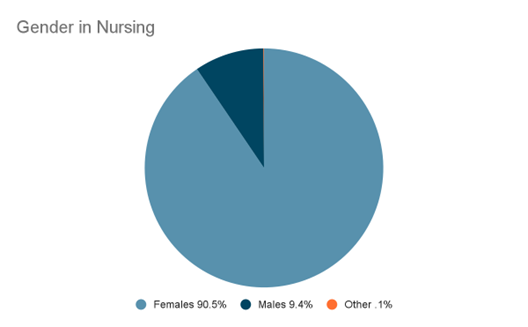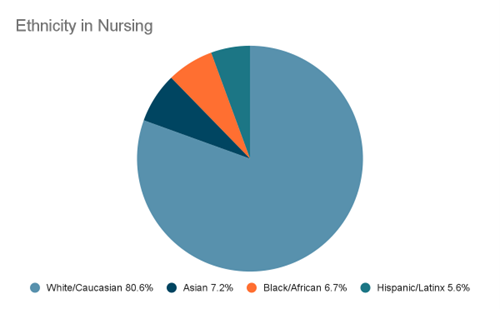Creating a Better Future Through Diversity in Nursing

The definition of diversity is the practice or quality of including or involving people from a range of social and ethnic backgrounds, different genders, sexual orientations, religions, etc. Understanding the definition is essential to understanding the critical role diversity plays in healthcare outcomes and actualizing the benefits and positive impact of cultural diversity in nursing.
In healthcare, diversity can enhance cultural competency in nursing practices, provide cross-cultural opportunities and allow nurses to enjoy more effective communication with patients from different backgrounds and beliefs.
A recent article published in Business News Daily explains how a diverse workforce fosters a healthy work environment, increases employee engagement and productivity and leads to creativity and innovation. The article’s author goes on to state that diversity, equity and inclusion efforts can ultimately have a positive impact on a company’s bottom line.
It’s not a stretch to suggest that creating these same culturally diverse environments in the healthcare space would inevitably have similar results — feelings of inclusion and acceptance in the workplace, resulting in improved employee morale.
While progress has been made toward cultural diversity in nursing, continuous improvement is critical to the future success of the U.S. healthcare system.
The Importance of Diversity in Nursing
A lack of cultural diversity in nursing creates barriers that could be the difference between life and death for a patient. According to a Health Professionals for Diversity report, when a patient’s unique cultural, communication and social needs are represented, access to care is improved. This should be top of mind throughout the recruitment and hiring process.
The need for more diversity in nursing becomes even more apparent when we examine U.S. population growth trends. It’s easy to see how a diverse workforce will play a significant role in ensuring equitable patient outcomes.
The Census Bureau’s diversity index measures the chance that two randomly selected people will be from different racial or ethnic groups. When reviewing this index, we can see two key points that reiterate the importance of diversity in nursing:
- Between 2010-2020, there was a 7% increase in diversity across the nation.
- It’s predicted that by 2060, one in three Americans will be Hispanic.
Understanding the importance of diversity in nursing is the first step toward building a more inclusive and representative workforce, which will result in better collaboration between patients and caregivers and ultimately improve health equity and reduce outcomes disparity in the U.S. healthcare system. A report by the National Library of Medicine shows that patients who feel more at ease when surrounded by caregivers with similar backgrounds and beliefs experience better patient outcomes.
Another report, also by the National Library of Medicine, explains how the quality of care is slowly improving for some minority groups. Still, others remain flat, especially when health disparities are related to age, race/ethnicity and income.
The Annual National Healthcare Quality and Disparities Report consistently shows that certain population groups receive inferior care. Black, Hispanic, American Indian, Asian and Alaska Native communities continue to see significant healthcare disparities. Cultural competency in nursing helps address these care and outcome inequities by reducing conscious and unconscious bias.
Although we know diversity in nursing is essential to better quality care, nationwide nursing shortages are impacting the entire healthcare system. These shortages, coupled with a growing minority population, are two reasons a concerted effort must be placed on creating a diverse nursing workforce.
The Current State of Diversity in Nursing
The above-noted nursing shortage and shift in demographics of the U.S. population begs the question — where does diversity in nursing stand currently?
The 2020 National Nursing Workforce Survey provides an account of the most recent data available.

- Females account for 90.5% of RNs.
- Males account for 9.4% of RNs.
- A third gender response option of “other” accounts for only 0.1% of nurses.

- 80.6% of RNs identify as White/Caucasian.
- 7.2% of RNs identify as Asian.
- 6.7% of RNs identify as Black/African American.
- 5.6% of RNs identify as Hispanic/Latinx.
While the current workforce is more diverse than ever, cultural diversity in nursing still lacks adequate representation. This contributes to patients encountering communication barriers, less culturally competent care and less favorable health outcomes.
How can we improve diversity in nursing?
An academic study titled, "Perceived Barriers to Success for Minority Students" shares some of the existing barriers that need to be removed or overcome if improving diversity in nursing is to be realized.
- Lack of financial support
- Insufficient advising
- Inadequate moral and emotional support
- Lack of mentoring
- Insufficient technical support
- Lack of institutional capacity
Universities and nursing education programs must make a dedicated effort to increase diversity by supporting underrepresented populations. Here are some ways they can achieve this:
- Ensure diverse populations are provided opportunities to enroll in programs and are first in line for cost savings initiatives and scholarships
- Provide support systems for moral and emotional support
- Present diverse students with access to technology
- Form groups or teams that encourage collaboration and reduce diverse students' isolation
- Employ bilingual advisors that are representative of different cultures
- Educate diverse students about programs designed to provide successful and attainable outcomes
Further, healthcare organizations need to make affordable education a strategic priority and continue implementing initiatives, such as tuition assistance programs that make higher education more attainable for minorities.
Healthcare leaders also need to encourage their organizations to invest in recruiting and retaining a diverse staff and enable employees to continue their education by building schedules that allow caregivers to work and attend classes.
Lastly, healthcare leaders can attract underrepresented populations by working with minority faculty members on recruitment strategies and prioritizing mentorship opportunities that promote a diverse student and employee population.
But this responsibility doesn’t just fall to healthcare and health system leaders. Educators and educational systems must also look for creative and innovative ways to encourage a culturally diverse workforce, recognizing solutions can’t only be applied to those entering nursing school. Nursing educators and mentors also need to reflect the diversity of new students entering the field.

Encourage Diversity in Nursing
The case has been made — cultural diversity in nursing is non-negotiable if we are to better meet the needs of a growing and changing population of patients and achieve healthcare equality.
Organizations that lack a diverse nursing or nursing education staff should urge leaders to take steps proven to ensure a diverse workplace. Consider new methods for recruitment by connecting with underserved populations or revamping the application processes to reduce inequities in hiring and attract a wider pool of applicants.
To build a more diverse healthcare system, organizations also need to continue educating employees about cultural awareness and inclusion and promote a climate that welcomes culturally diverse employees, fosters collaboration and fairness and eliminates existing barriers.
Explore Online Nursing Degrees from Wilkes University
Improving cultural diversity in nursing can start with you. Whether you are considering becoming an RN or want to take your nursing career to the next level with a master’s or a doctorate in nursing, there are numerous online programs and certificates available at Wilkes University.
Take the next step today in your career and check out the online nursing degree opportunities available at Wilkes University.




